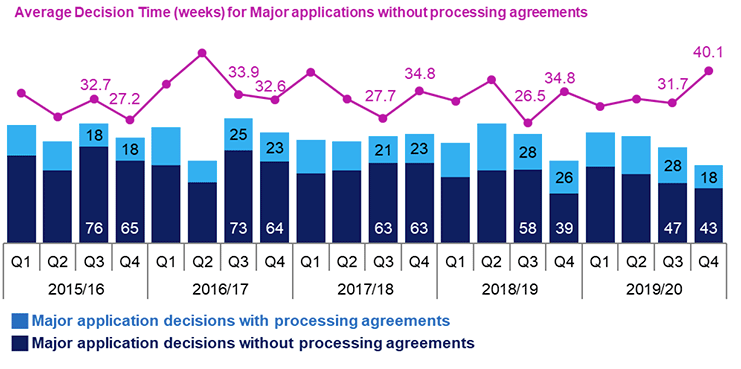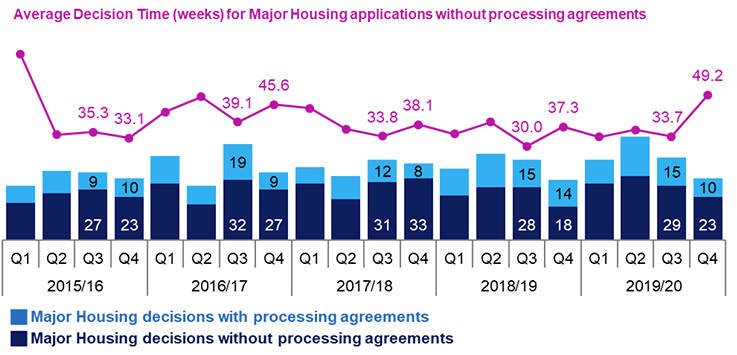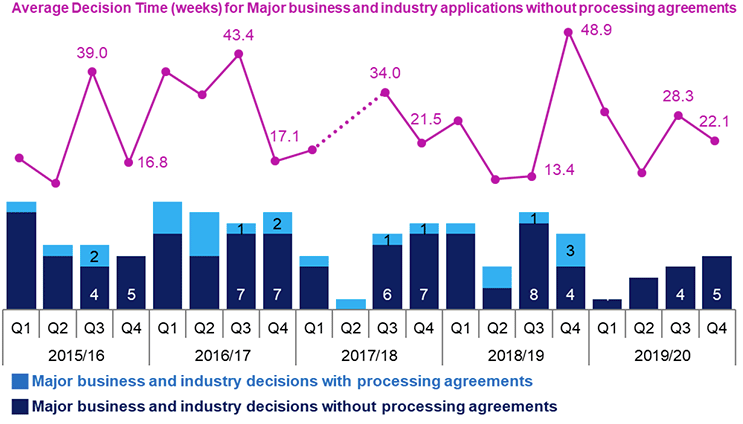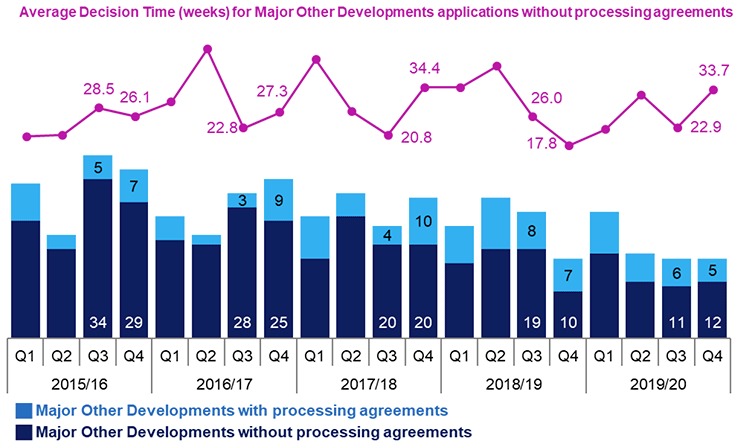Planning performance statistics 2019/2020: quarterly (October to March)
Summary statistics on planning decision-making and timescales for April 2019 to March 2020 with historic data going back to 2015/2016. It is based on data we collect from local and planning authorities as part of the Planning Performance Framework (introduced in 2012).
3. Major Developments
Major developments include applications for developments of 50 or more homes, as well as other applications covering areas of development such as minerals, housing, business and industry, waste management, electricity generation, fish farming and other developments.
Classification between local and major developments depends on the particular development type. For example, housing developments are classed as major when the application is for 50 or more dwellings or for a site that exceeds two hectares, whereas electricity generation is classed as major when the capacity of the generating station is or exceeds 20 megawatts.
This section presents quarterly information on average timescales across all major developments, along with separate figures for the key categories of housing, business and industry and other developments. Information on other categories of major developments is reported on an annual rather than quarterly basis.
Decision times for major applications may vary greatly between applications so average figures based on a small number of applications can be volatile.
Some local authorities use processing agreements where the developer and the local authority agree on timescales for decisions. When an application is subject to a processing agreement it is not included in average decision time calculations.
Legacy cases validated before 3rd August 2009 are not included in the figures but are reported separately in Section 10. Figures for all applications including legacy cases were reported up to and including 2016/17 and are available in previous publications.
3.1. All Major Developments
There were 90 major development applications not subject to processing agreements in the final six months of 2019/20, seven fewer than in the same period in 2018/19. The average decision time was 35.7 weeks, almost six weeks slower than the 29.8 weeks for the same period in the previous year.
In addition a number of applications were concluded that were subject to processing agreements, these are not included in average time calculations. In quarter three of 2019/20 there were 28 major development applications with processing agreements, 75.0% (21) of these met agreed timescales that had been set between developers and local authorities. In quarter four there were 18, 55.6% (10) meeting the agreed timescales.
In quarter three major applications with processing agreements accounted for 37.3% of all major development decisions, in quarter four they accounted for 29.5%.
There was also one major pre 3rd August 2009 legacy case concluded. Further details about legacy cases are in Section 10.

The average decision time figures of 31.7 and 40.1 weeks for quarters three and four have been influenced by a number of lengthier decision times, including 19 decision times of longer than a year – seven in quarter three and twelve in quarter four. Two in each quarter had decision times of longer than two years. The longest in quarter three taking just under 3 years and the longest in quarter four taking four years.
Just under three quarters (34 of 47) of major development applications decided in quarter three were decided in a time that was quicker than the quarter three average. In quarter four almost two thirds (28 of 43) were decided in a time quicker than the average for that quarter. Further information on the distribution of decision times for major development applications is given in Annex A.
City of Edinburgh made most decisions on major developments in the final six months of 2019/20, 14 in total. In quarter three they determined five major development applications, three of these being subject to a processing agreement. In quarter four they determined nine, also with three subject to a processing agreement.
3.2. Major Housing Developments
Major Housing developments are those with 50 or more dwellings or with a site area that is or exceeds 2 hectares where the predominant use is for housing.
There were 52 major housing developments not subject to processing agreements decided during the final six months of 2019/20, six more than in the same period in the previous year. The average decision time was 40.5 weeks, more than seven weeks slower than the 32.9 weeks for the same period in the previous year.
In addition a number of applications were concluded that were subject to processing agreements, these are not included in average time calculations. In quarter three of 2019/20 there were 15 major housing applications with processing agreements, 80.0% (12) of these met agreed timescales set between developers and local authorities. In quarter four there were 10, 60.0% (6) meeting the agreed timescales.

Average figures based on a small number of applications can be volatile. In quarter three five major housing applications had decision times of more than one year, the longest taking just under three years. The average decision time of 33.7 weeks was significantly influenced by the application with the longest decision time; the average decision time for the remaining 28 applications was 29.4 weeks, more than four weeks quicker. In quarter four, eight major housing applications had decision times of more than one year, the longest taking four years. The average decision time (49.2 weeks) was significantly influenced by the application taking four years with the remaining 22 applications averaging 41.9 weeks, more than seven weeks quicker. For further detail on the distribution of decision times for major housing see Annex A.
There was also one major housing pre 3rd August 2009 legacy case concluded. Further details about legacy cases are in Section 10.
3.3. Major Business and Industry
Business and industry developments include construction of a building or structure for any of the following: use as an office, for research and development of products or processes, for any industrial process or for use for storage or as a distribution centre.
To be classed as major the gross floor space as a result of the development must exceed 10,000 square metres or the site area must exceed 2 hectares.
There were nine major business and industry developments not subject to processing agreements decided during the final six months of 2019/20, three fewer than in the same period in 2018/19. The average decision time of 24.9 weeks was 2 days quicker than the 25.2 weeks in the final six months of 2018/19. The number of major business and industry applications is very small and so average decision times may be significantly influenced by the decision time for a single application.
No major business and industry applications subject to processing agreements were determined in the final six months of 2019/20.

There were no business and industry applications not subject to processing agreements in quarter 2 of 2017/18 therefore there was no average decision time.
3.4. Major Other Developments
Other developments are developments not falling wholly within any other single class. They include but are not limited to retail, leisure and entertainment, education, healthcare, community facilities, transport interchanges, water and drainage developments and projects. This class also covers mixed use projects.
Major other developments are where the gross floor space of any building, structure or erection as a result of such development is or exceeds 5,000 square metres or the area of the site is or exceeds 2 hectares.
There were 23 major other developments not subject to processing agreements decided during the final six months of 2019/20, six fewer than in the equivalent period in the previous year. The average decision time was 28.5 weeks, more than five weeks slower than the 23.2 weeks for the same period in the previous year.
In addition a number of applications were concluded that were subject to processing agreements, these are not included in average time calculations. In quarter three of 2019/20 there were six major other developments applications with processing agreements, 66.7% (4) of these applications met agreed timescales that had been set between developers and local authorities. In quarter four there were five, 40.0% (2) meeting the agreed timescales.

In quarter three one major other development application had a decision time of more than a year which influenced the average decision time of 22.9 weeks. The average decision time for the remaining 10 applications was 19.3 weeks, more than three weeks quicker. In quarter four, three major other development applications had decision times of more than a year, the longest taking 1.8 years. The average decision time of 33.7 weeks was significantly influenced by the application with the longest decision time. The average decision time for the remaining 11 applications was 28.4 weeks, more than five weeks quicker. Further detail on the distribution of decision times for major other developments is available in Annex A.
Contact
Email: planstats@gov.scot
There is a problem
Thanks for your feedback